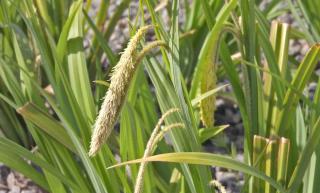

Carex are cute grasses well-known for the diverse hues of their foliage.
Core Sedge or Carex facts
Name – Carex
Family – Cyperaceae
Type – perennial, grass
Height – 1 ½ feet (50 cm)
Exposure – full sun or part sun
Soil – ordinary, rather moist
Foliage – evergreen
Flowering – July to October
Planting density – 7 to a square yard or meter
Caring for this plant from planting to pruning will enable you to make it even more beautiful.
Indifferently, in fall or spring.
To produce a covering effect, provide about 7 plants to a square yard (1 m²).
Multiply through crown division in spring.
They don’t need any pruning.
You can remove faded inflorescences as they die away.
Typically, grasses adapt to drought by drying out. Carex is no exception, but it will truly thrive if you plant it in moist soil.
Carex being the name of the family, a lot of different species are available in garden stores. Some are short and form clumps, like Oshima sedge, while others grow taller like C. spicata.
 Sedge, which is the generic name used for several Carex species, is a particularly interesting grass because it stays beautiful all year round.
Sedge, which is the generic name used for several Carex species, is a particularly interesting grass because it stays beautiful all year round.
Its discrete flowering doesn’t overshadow its leafage that forms a beautiful persistent and resistant bunch.
You would best set it up in a moist spot, near a body of water or in cool soil.
It is easy to grow, and hardy, too, although most species wouldn’t survive extended freezing.
Read also:
These plants are often as wide as they are tall, so they must be spaced accordingly.